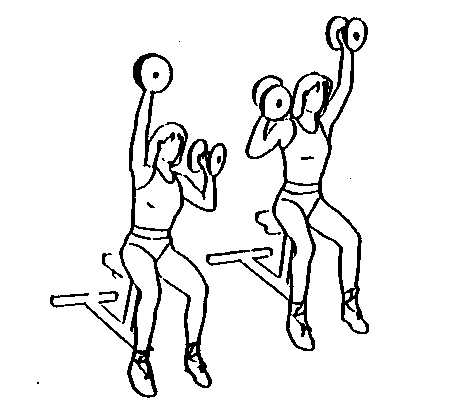












          |
   |
Strength training refers to exercise that requires your muscles to exert a force against some form of resistance, such as free weights. Performing strength training exercises 2-3 x a week for 20 minutes yields terrific results.
What are the benefits of strength training?
Strength training is the fastest way to improve muscle strength and endurance. The increase in muscle strength and endurance allows a person to perform everyday tasks with less effort and for longer periods of time. Many changes in muscle tissue that are associated with age are caused by disuse. Simply forcing the muscles to work on a regular basis significantly improves their capacity to do work. Resistance training can also improve circulation, coordination, balance, bone and ligament strength.
Is it safe for a woman to participate in strength training?
Some misconceptions associated with weight training are that women would produce bulging muscles and/or they would seriously injure themselves lifting weights. It is very difficult for a woman to produce large muscles due to the fact that women generally have high levels of the hormone estrogen. The fact is improvements are made in muscle tone, strength and endurance and not necessarily in size. As muscles become toned, the body begins to lose fat tissue and becomes more firm. When it comes to strength training, anything that is considered a healthy practice for men is also healthy for women.
Is it necessary to stretch before and after performing free weight exercises?
Yes, stretching before exercise prepares the joints for motion, helps avoid injury and increases the range of motion of the area being stretched. After exercise stretching reduces soreness, helps to prevent muscle cramping and increases the range of motion. When stretching it is important to remember to stretch until you feel a slight tension and hold for 10-20 seconds. Do NOT bounce. Never stretch until it hurts and stay relaxed throughout the stretch. Aerobic exercise and stretching should be performed first followed by resistance training participation. Trained professionals should demonstrate proper form and technique of each exercise before participation is encouraged.
Below are examples of some strength-training exercises for women | |
1. SIDE SHOULDER RAISE—for outer portion of the shoulders | |
|

|
2. FRONT SHOULDER RAISE—for front portion of the shoulders | |
|

|
3. UPRIGHT ROW—for shoulders, neck and upper Back | |
|

|
4. BICEPS CURL—for biceps or front of arm | |
|

|
5. ONE-ARM DUMBELL TRICEPS CURL—for triceps | |
|

|
6. ALTERNATED DUMBBELL PRESS—for front and outer deltoids | |
|

|
This Exercise page was contributed by Kathleen B.Williamson, MS, RN, C, Coordinator of Cardiopulmonary Fitness and Rehabilitation Services at Capital Health System in Trenton, NJ.
Diet and Exercise Log | Exercising Safely | An Exercise Calendar | Strength Training | Starting a Walking Program | Stretching Exercises | Relaxation Exercises | Living with Mindfulness | Intro to Exercise | Yoga
Disclaimer | Donate Now | Contact Us | Site Map | Store
|
©1999-2000; updates: 2002, 2004, 2005, 2007 Women's Heart Foundation, Inc. All rights reserved. Unauthorized use prohibited. The information contained in this Women's Heart Foundation (WHF) Web site is not a substitute for medical advice or treatment, and WHF recommends consultation with your doctor or health care professional. |